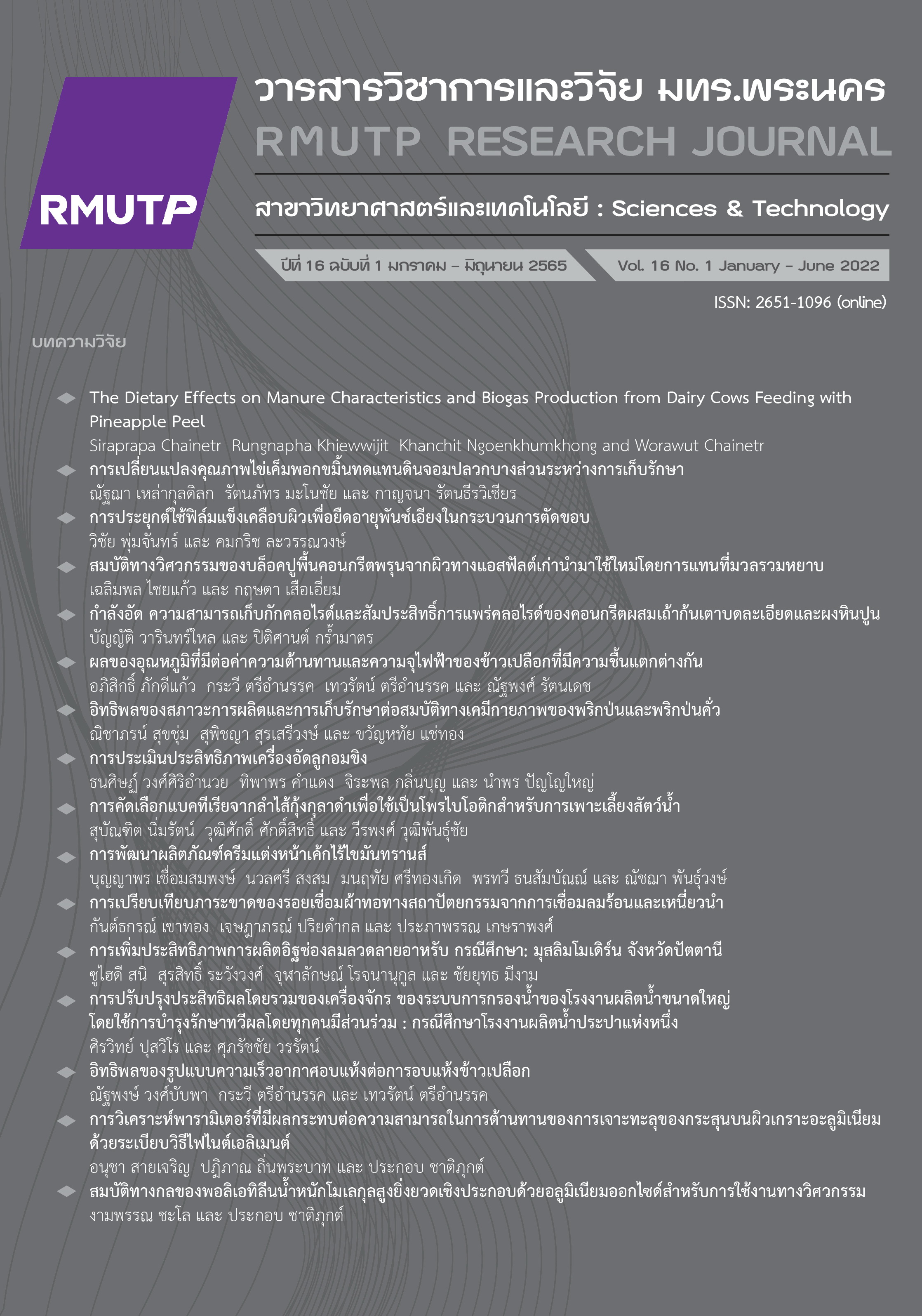Screening of Bacteria Isolated from Black Tiger Shrimp (Penaeus monodon) Intestine Using as Probiotics in Aquaculture
Main Article Content
Abstract
In this study, 14 bacterial strains isolated from gastrointestinal tract of black tiger shrimp (Penaeus monodon) was investigated for their probiotic potential. The results showed that 6 strains, namely S1, S3, S6, S7, T4 and T5 were able to degrade 3 nutrient substances including protein, starch, and lipid among which S3, S7, and S2 were the best tested nutrient-degrading bacteria, respectively. Six bacterial strains were unable to lyse red blood cells including S2, S3, T0, T1, T2 and T3. S2 strain showed the strongest antibacterial activity against shrimp pathogenic Vibrio harveyi following an agar overlay technique. Based on environmental tolerance tests, S2 and T0 strains grew well under wide ranges of environmental conditions, e.g. sodium chloride concentration (0-8%), pH (6-10), and temperature (25-37°C). As a consequence, S2 strain had the most probiotic potential for shrimp culture owing to no hemolysis of red blood cells, inhibition of V. harveyi growth, protein and lipid degrading ability, and high environmental tolerance for shrimp cultivation. The strain was identified as Micrococcus sp. S2. However, additional study focused on immune response, nutrient digestibility and growth promotion of the strain should be further performed in marine shrimp.
Article Details

This work is licensed under a Creative Commons Attribution-NonCommercial-NoDerivatives 4.0 International License.
ลิขสิทธ์ ของมหาวิทยาลัยเทคโนโลยีราชมงคลพระนครReferences
Fisheries Statistics of Thailand, Statistics of Marine Shrimp Culture 2017. Fisheries Statistics Analysis and Research Group, Fisheries Development Policy and Strategy Division, Department of Fisheries, Ministry of Agriculture and Cooperatives, No. 9/2019, 2019.
F.C. Cabello, H.P. Godfrey, A.H. Buschmann and H.J. Dölz, “Aquaculture as yet another environmental gateway to the development and globalisation of antimicrobial resistance,” Lancet Infectious Diseases, vol. 16, no. 7, pp. e127-e133, Jul. 2016.
F.J. Gatesoupe, “The use of probiotics in aquaculture,” Aquaculture, vol. 180, no. 1-2, pp. 147-165, Oct. 1999.
T. Boonthai, V. Vuthiphandchai and S. Nimrat, “Probiotic bacteria effects on growth and bacterial composition of black tiger shrimp (Penaeus monodon),” Aquaculture Nutrition, vol. 17, no. 6, pp. 634-644, Dec. 2011.
S. Nimrat, T. Boonthai and V. Vuthiphandchai, “Effects of probiotic forms, compositions of and mode of probiotic administration on rearing of Pacific white shrimp (Litopenaeus vannamei) larvae and postlarvae,” Animal Feed Science and Technology, vol. 169, no. 3-4, pp. 244-258, Nov. 2011.
S. Nimrat, S. Suksawat, T. Boonthai and V. Vuthiphandchai, “Potential Bacillus probiotics enhance bacterial numbers, water quality and growth during early development of white shrimp (Litopenaeus vannamei),” Veterinary Microbiology, vol. 159, no. 3-4, pp. 443-450, Oct. 2012.
N.V. Hai, “The use of probiotics in aquaculture: review,” Journal of Applied Microbiology, vol. 119, no. 4, pp. 917-935, Oct. 2015.
S. Nimrat, W. Khaopong, J. Sangsong, T. Boonthai and V. Vuthiphandchai, “Improvement of growth performance, water quality and disease resistance against Vibrio harveyi of postlarval whiteleg shrimp (Litopenaeus vannamei) by administration of mixed microencapsulated Bacillus probiotics,” Aquaculture Nutrition, vol. 26, no. 5, pp. 1407-1418, Oct. 2020.
S. Nimrat, P. Kaewmanee, T. Boonthai and V. Vuthiphandchai, “Field survey on the use of probiotic in Pacific white shrimp (Litopenaeus vannamei) aquaculture in Rayong province,” Burapha Science Journal, vol. 14, no. 1, pp. 56-69, 2009.
S. Rengpipat, W. Phianphak, S. Piyatiratitivorakul and P. Menasveta, “Effects of a probiotic bacterium on black tiger shrimp Penaeus monodon survival and growth,” Aquaculture, vol. 167, no. 3-4, pp. 301-313, Sep. 1998.
S. Nimrat and V. Vuthiphandchai, “In vitro evaluation of commercial probiotic products used for marine shrimp cultivation in Thailand,” African Journal of Biotechnology, vol. 10, no. 22, pp. 4643-4650, 2011.
S.R. Spelhaug and S.K. Halander, “Inhibition of foodborne bacteria pathogens by bacteriocin from Lactococcus lactis and Pediococcus pentosaceous,” Journal of Food Protection, vol. 52, no. 12, pp. 856-862, Dec. 1989.
J.G. Holt, N.R. Krieg, P.H.A. Sneath, J.T. Staley and S.T. Williams, Bergey’s Manual of Determinative Bacteriology. Baltimore: Williams and Wilkins, 1994.
S.Y. Shiau, “Nutrient requirements of penaeid shrimps,” Aquaculture, vol. 164, no. 1-4, pp. 77-93, May 1998.
D.M. Akiyama, W.G. Dominy and A.L. Lawrence, “Penaeid shrimp nutrition for the commercial feed industry,” in Proceedings of the Aquaculture Feed Processing and Nutrition Workshop, American Soybean Association, Singapore, 1991, pp. 80-98.
A.M. Abd El-Rhman, Y.A.E. Khattab and A.M.E. Shalaby, “Micrococcus luteus and Pseudomonas species as probiotics for promoting the growth performance and health of Nile tilapia, Oreochromis niloticus,” Fish and Shellfish Immunology, vol. 27, no. 2, pp. 175-180, Aug. 2009.
A. Akbar, U. Sitara, I. Ali, N. Muhammad and S.A. Khan, “Isolation and characterization of biotechnologically potent Micrococcus luteus strain from environment,” Pakistan Journal of Zoology, vol. 46, no. 4, pp. 967-973, Aug. 2014.
B.H. Çadirci and S. Çitak, “A comparison of two methods used for measuring antagonistic activity of lactic acid bacteria,” Pakistan Journal of Nutrition, vol. 4, no. 4, pp. 237-241, Apr. 2005.
M. Zaky and W. Zina, Pathogenic Hemolytic Bacteria. Germany: LAP Lambert Academic Publishing, 2016.
N. Butkhot, P. Soodsawaeng, T. Boonthai, V. Vuthiphandchai and S. Nimrat, “Properties and safety evaluation of Bacillus velezensis BUU004 as probiotic and biopreservative in seafood products,” Southeast Asian Journal of Tropical Medicine and Public Health, vol. 51, no. 2, pp. 201-211, Jun. 2020.
M. Thongsom and L. Chanudom, “Isolation of lactic acid bacteria from mantis shrimp (Harpiosquilla raphidea) intestine for probiotic development,” RMUTSV Research Journal, vol. 11, no. 2, pp. 232-244, 2019.
S.P. Antony, I.S.B. Singh, R.M. Jose, P.R.A. Kumar and R. Philip, “Antimicrobial peptide gene expression in tiger shrimp, Penaeus monodon in response to gram-positive bacterial probionts and white spot virus challenge,” Aquaculture, vol. 316, no. 1-4, pp. 6-12, Jun. 2011.
S. Nimrat, P. Tanutpongpalin, K. Sritunyalucksana, T. Boonthai and V. Vuthiphandchai, “Enhancement of growth performance, digestive enzyme activities and disease resistance in black tiger shrimp (Penaeus monodon) postlarvae by potential probiotics,” Aquaculture International, vol. 21, no. 3, pp. 655-666, Oct. 2013.


